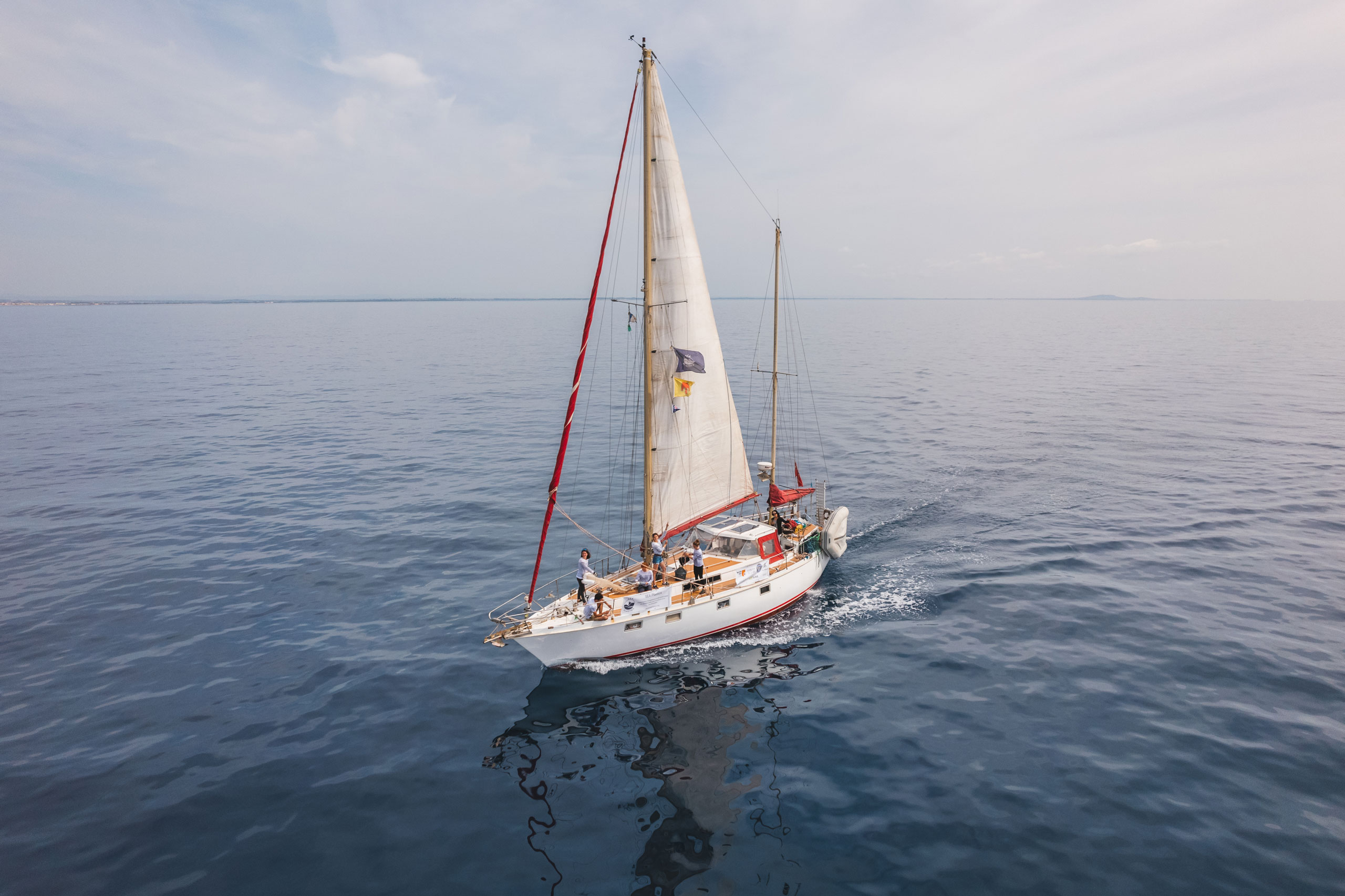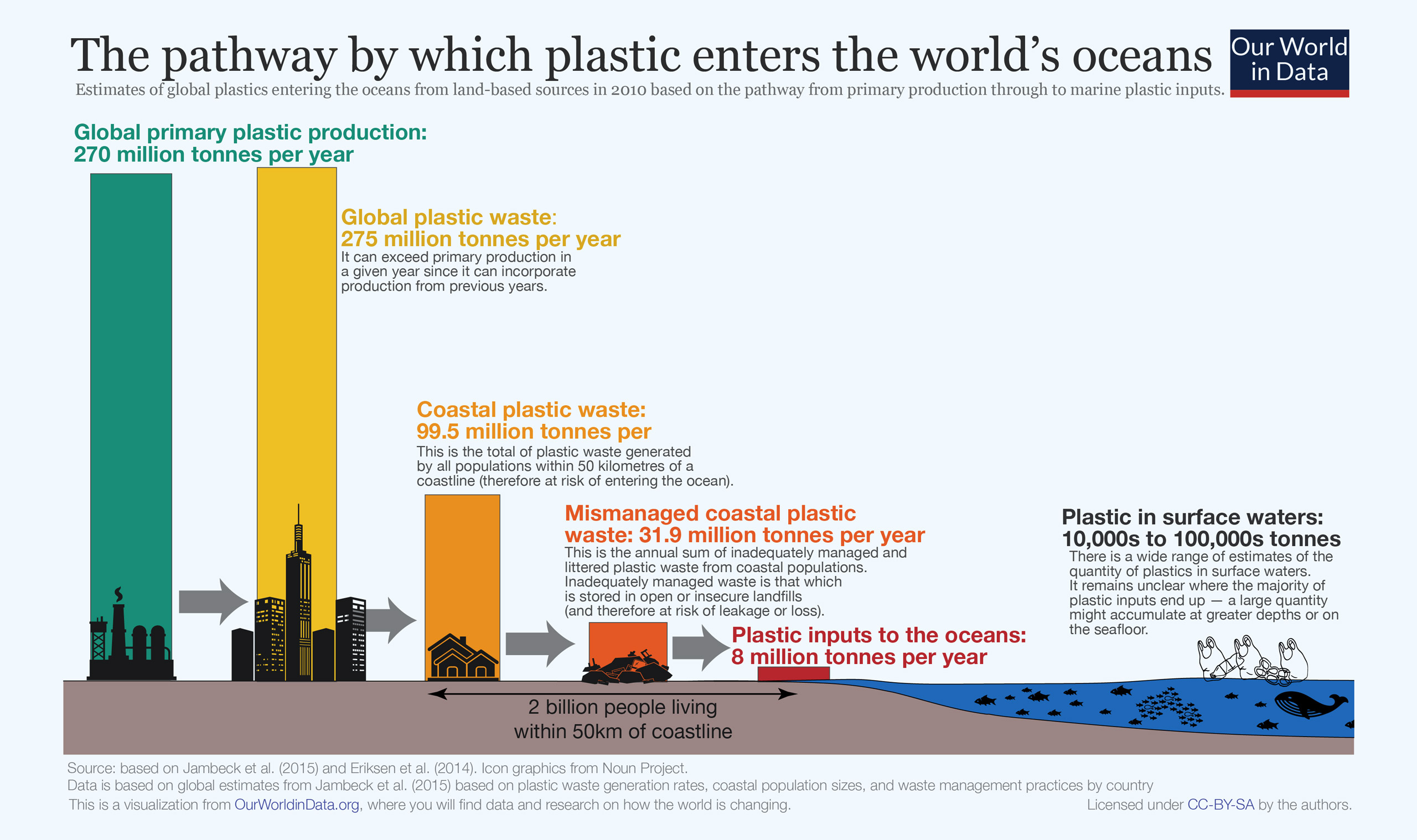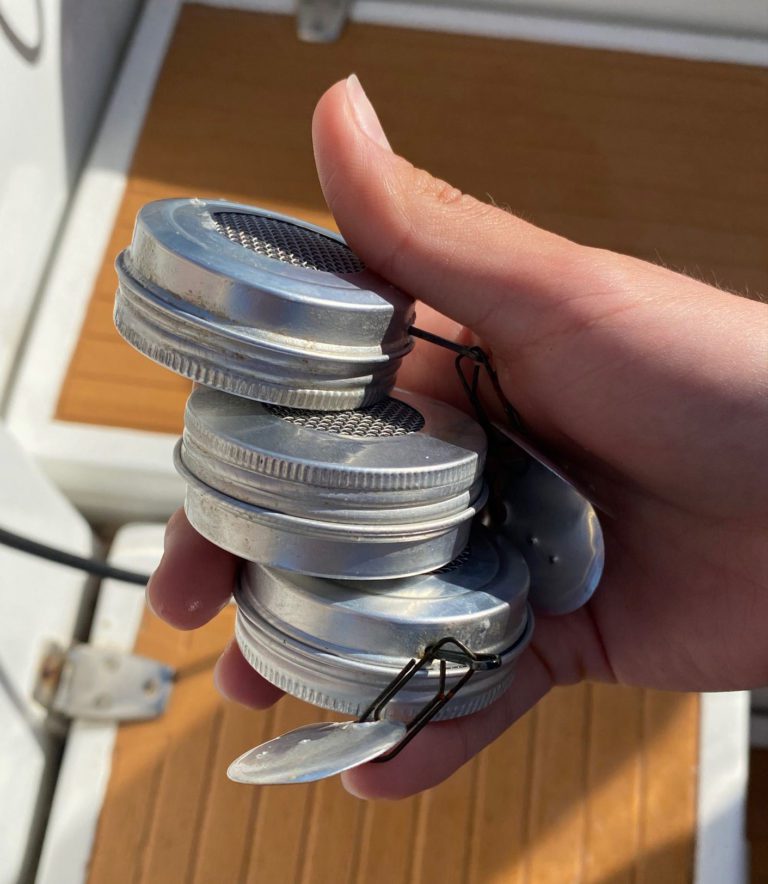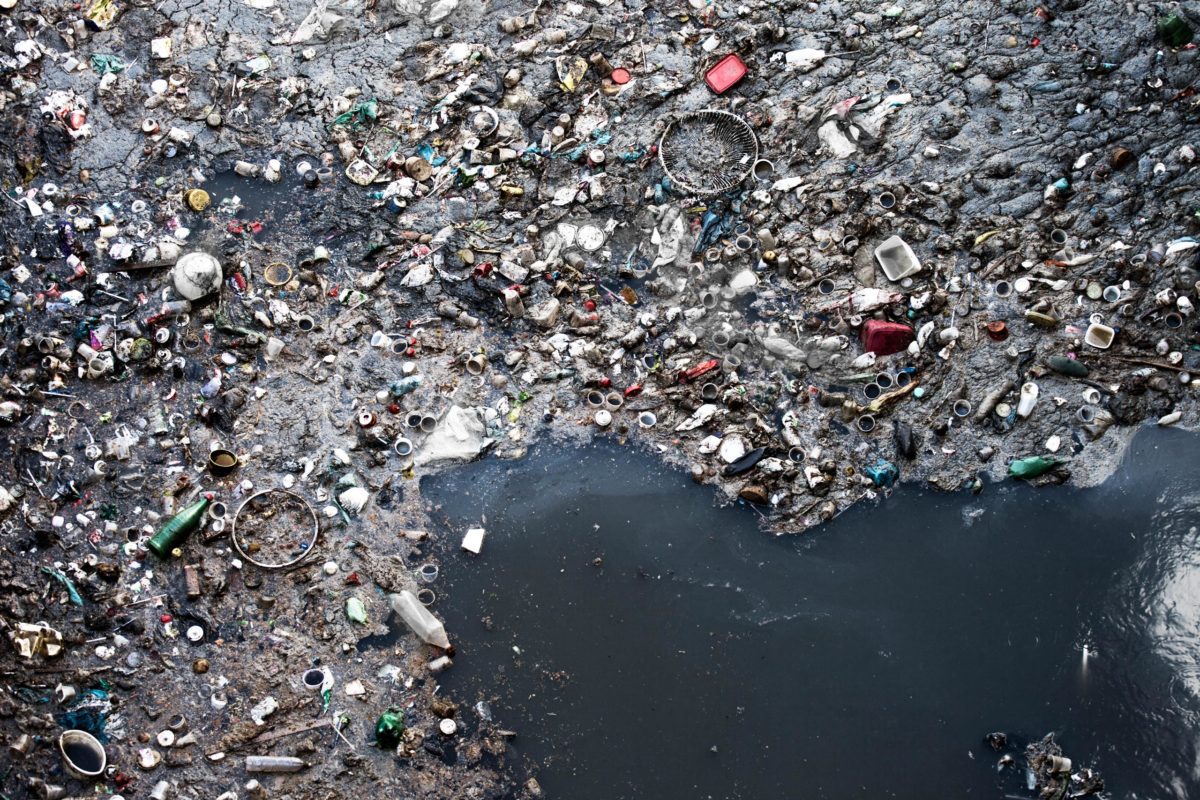Laurine is standing at the rear of the ship, diligently filling one bucket after another. But she isn’t bailing out the boat. She’s taking water from the sea, one liter at a time, and pouring it into a series of large glass jars on the deck. The 22-year-old EPFL student is performing this task several times a day as part of her Master’s research: a joint project backed by the School of Life Sciences (SV) and the School of Architecture, Civil and Environmental Engineering (ENAC) exploring how pollutants and plastic particles interact in marine waters.
Laurine is taking part in an annual expedition run by SEA Plastics, a non-profit organization founded in 2016 by students from AgroParisTech – a French institute of technology specializing in life and environmental sciences – to conduct scientific research and raise public awareness of the threat posed by plastic pollution. Each summer, a new group of students has embarked on a voyage around the Mediterranean, carrying out experiments and collecting samples.
- Science is gradually revealing the scale of microplastic pollution
- We are studying the multiple impacts of microplastics
The 2022 cohort is the sixth group to take part in the expedition. With Laurine are four students from AgroParisTech: Alice, Clara and Anne-Laure, who have been on board since the outset, and Numa, the only male member of the team, who joined them partway through. The group set off from Gibraltar in late March, traveling up Spain’s eastern coast before sailing across to Marseille and then heading west. They faced a longer-than-expected stopover at the French port of Gruissan, after unforeseen circumstances meant they had to find a new boat. But they managed to set sail again in good time, heading for Corsica and Sardinia.
Despite the stunning backdrop, this is anything but a leisure cruise. The team has a packed work schedule: when they’re not collecting samples out at sea, they’re busy raising awareness at their ports of call – speaking to schoolchildren on board and in local schools, holding stands at street markets, giving lectures, talking to marine professionals, and more.

Hunting down plastic in the ocean
The scientific aims of this year’s expedition are to develop new microplastic characterization methods, to study micropollutant transport patterns, and to gather data on how different environmental factors affect the plastic aging process. Laurine is the team’s scientific lead and is in charge of carrying out on-board experiments, some of which she developed with support from EPFL’s Central Environmental Laboratory (CEL).
As part of her research, Laurine is exploring how marine pollution from human activities – hydrocarbon residues, drugs, pesticides, heavy metals, and so on – interacts with different types of microplastics. Her goal is to observe the chemical bonds that form between the various molecules, and how this process is affected by temperature, salinity, dissolved oxygen concentration, current strength and velocity, acidity (pH), pressure, light and other factors.
More specifically, Laurine’s research focuses on the dynamics of adsorption – the propensity of chemical and organic molecules to adhere to and detach from a surface (in this case, microplastics). To achieve this aim, she designed a research protocol that allows her to observe the conditions under which pollutants bonded to microplastics are re-released into the environment.
Before heading off for the expedition, Laurine built more than 300 aluminum filter boxes. She spent hours at the CEL, grating chunks of plastic, dipping others in liquid nitrogen or grinding them to prevent the fibers from becoming twisted, in order to produce five different types of powder, including some of the most common plastics found in marine waters: polypropylene (PP), polystyrene (PS), polyethylene terephthalate (PET) and polyvinyl chloride (PVC). The water collected from the sea and stored in the glass jars is poured into the aluminum boxes, each carefully filled with powder, so that the water comes into contact with the plastics. At 18 predetermined points in the voyage, the team takes out a handful of these boxes, labels them and stores them in a cool, dark place for later analysis in the lab.
This expedition showed us what research is like out in the field”
Samples galore
The students are collecting a number of other samples too. For instance, as part of an experiment to assess the aging process of certain plastics, they’ve tied strips at different heights: on the mast, on the deck, and in the water, dragged behind the boat. These strips are removed and replaced every 10 to 12 days. “The idea is to observe how UV rays, wind and sea spray alter the structure of these plastics over time,” explains Laurine. “Back at the lab, we’ll analyze the strips under a scanning electron microscope and cross-reference our observations with meteorological data from the point at which we sampled them.”
The SEA Plastics expedition team is also gathering surface samples using a Manta net – so named because its largest section is shaped like the head of a ray — as well as samples at different locations in the water column using an opening-closing net. The students are collecting these samples for Oceaneye, a Geneva-based non-profit organization that is using citizen science as a way to build an international database on plastic pollution in the Mediterranean.

The SEA Plastics expedition team is also gathering surface samples using a Manta net © Jamani Caillet/EPFL
At the end of the journey in late July, the team will disembark on France’s southeastern coast. For these five young scientists, the 2022 SEA Plastics expedition is likely to have been a life-changing experience.
“This expedition showed us what research is like out in the field,” say the team members. “We learned a lot about how to adapt and come up with solutions on the fly. But we also got to meet some really interesting people, share some incredible experiences and see some breathtaking landscapes. Above all, it was a very enriching experience personally.”■
References
SEA Plastics: https://www.seaplastics.org/
EPFL Out there : https://epfloutthere.tumblr.com/tagged/seaplastics
OceanEye: https://www.oceaneye.ch/
Swiss Cetacean Society: https://www.swisscetaceansociety.org/
Tous les partenaires: https://www.seaplastics.org/partenaires
Nowhere on Earth is free from microplastics. These tiny particles have been discovered at the top of Mount Everest, at the bottom of the Mariana Trench, on the most remote beaches in the South Pacific, in the leaves of trees and even inside our organs. The scientific community is gradually coming to understand this pervasive, multifaceted problem. And while uncertainties remain as to the true scale of microplastic pollution, we are learning more and more about its impact on ecosystems, biodiversity, the climate and human health.
This article on the current state of play in microplastic research accompanies a report on a week spent with SEA Plastics, a non-profit organization that conducts an annual research expedition in the Mediterranean. On that expedition, a group of young scientists takes measurements and collects samples to further our understanding of microplastic pollution. They also carry out awareness-raising activities at their ports of call. Laurine Planat, a student at EPFL’s School of Life Sciences (SV), is one of the members of this year’s team. Her research is being supported by the Central Environmental Laboratory (CEL) at EPFL’s School of Architecture, Civil and Environmental Engineering (ENAC).
The volume of plastic we produce is growing exponentially: from around two million tons per year in the 1950s, when plastic was invented, to 160 million tons in the early 1990s. By 2015, that figure had jumped to almost 450 million tons – and, at the same rate of growth, it could be 20% higher again by 2050. An estimated nine billion tons of plastic have been produced to date. Less than 10% of all plastic items are currently recycled, with the remainder being incinerated or ending up in landfills or discarded in the environment. These figures might seem a little abstract, but they give a sense of the scale of the problem, the ease with which plastic pollution spreads around the globe, and the urgent need for further research.
“It’s very hard to quantity the problem accurately,” says Florian Breider, who heads the CEL. “Most of the data on microplastics in marine waters come from surface samples, but we’re lacking measurements for the whole water column. We need this information so we can understand how and in what quantities these particles sink, reach the sediment on the ocean floor and accumulate in the deepest waters.”
It’s very hard to quantity the problem accurately”

An invisible and pernicious threat
Public awareness of the problem is on the rise. Images of piles of bottles and other waste clogging up rivers and heaped on beaches regularly appear on our screens and in social media. Perhaps one of the best-known examples is the Great Pacific Garbage Patch – a swirling mass of plastic consumer waste discarded over the course of several decades and now concentrated in the North Pacific vortex.
Images such as these may be powerful, but they only represent the tip of the iceberg. Much remains unknown or poorly understood about this kind of pollution. This is especially true for microplastics: small pieces of plastic less than five millimeters across. As well as being harmful, these particles are also invisible to the naked eye, with estimates suggesting that visible waste accounts for just 1% of the plastic held by the seas and oceans.
And then there are nanoplastics, even tinier fragments measuring between one micrometer and 100 nanometers in diameter. At such a minute scale, this type of pollution is even harder to measure and quantify. But scientists have already found these particles in almost every ecosystem on Earth – and even inside living organisms. In a study published in April this year, the Swiss Federal Institute for Forest, Snow and Landscape Research (WSL) reported evidence of nanoplastics accumulating in the roots of forest trees, from where they are transported to branches and leaves.
These nanoparticles, which are present in the food we eat, the water we drink and even the air we breathe, are absorbed into our organs and other bodily tissues. “Their effects on human health are still poorly understood,” says Breider. “But we do know that these particles find their way deep into our organs. Over time, there’s a risk that toxic substances could leach out and accumulate in the body, causing inflammatory responses and other health issues.” Breider is currently working with the Center for Primary Care and Public Health (Unisanté) and Lausanne University Hospital (CHUV) on research into plastics in the lungs, kidneys and bloodstream.
Nanoplastics accumulating in the roots of forest trees”

Tire dust
These tiny plastic particles come from various sources. Some are produced when plastic objects discarded in the environment degrade and break down over time – a source that has long been underestimated. Others come from our clothes, most of which are now made from petroleum-based synthetic fibers such as polyester, polyamide, acrylic, polyurethane and elastane. Each time we wash these garments, they shed hundreds of thousands of microfibers. These can end up in rivers and be carried downstream to the sea. There’s also a third source that, while less well-publicized, is responsible for a large share of the polymers found in the environment: tire and road wear particles.
A paper published two years ago in Science pointed the finger at an additive commonly used in the production of tires to prevent damage to the rubber from ozone. The authors reported that this molecule, which was found in rivers across the U.S. Pacific Northwest as a result of road runoff, was responsible for high rates of mortality among salmon when they returned to urban and suburban waterways to breed, leading to a 50–90% decline in population numbers.
The same problem has been observed much closer to home: research by the CEL suggests that tire dust accounts for as much as 30–40% of the plastic particles found in Lake Geneva. The team at the EPFL lab is continuing to analyze the chemical compounds and heavy metals contained in these residues, some of which can form new, potentially toxic molecules as they degrade. The researchers are especially interested in how these pollutants affect fish and other marine animals – and how they travel up the food chain to humans. Using synthetic gastric and intestinal fluids that mimic the conditions in the digestive system of trout, they are testing the bioavailability of these molecules, i.e., the extent to which they are absorbed through the gut wall or into the bloodstream. The samples collected by the SEA Plastics team will also be analyzed using this same method.
Plastic pollution is thus a problem that affects every part of the world: some 80% of plastic waste enters the environment on dry land, often miles from the coast, before being carried downstream by rivers. After entering the seas and oceans, it’s slowly broken down into ever-smaller particles. These microplastics have serious consequences for ecosystems – in ways we are only just beginning to understand – and for the climate.
30–40% of the plastic particles found in Lake Geneva”

Oil and the greenhouse effect
While larger chunks of plastic can block the respiratory and digestive tracts of many animal species, microscopic particles are also very harmful. These tiny pieces of plastic are consumed by plankton, which are microscopic organisms at the bottom of the food chain. As a result, the plastic climbs the chain to humans via contaminated seafood. What’s more, once ingested, these microplastics can build up in the stomach, making it harder for the body to extract vital nutrients from food.
According to a 2019 report by the World Wide Fund for Nature (WWF), we could be ingesting as much as five grams of plastic every week, which is the equivalent weight of a credit card. This is concerning because the endocrine-disrupting chemicals used as additives in some plastics could disturb major bodily functions, potentially leading to reproductive disorders and increased cancer risk.
We could be ingesting as much as five grams of plastic every week,”
Last but not least, plastic pollution is a significant contributor to climate change. An estimated 5–10% of all the oil we extract – a process that involves ever deeper and more energy-intensive drilling – is used to make plastic products. And only around 10% of this plastic is actually recycled. “Much of the rest is incinerated, often in poorly controlled conditions, which releases large quantities of greenhouse gases into the atmosphere and drives global warming,” says Breider, who adds that plastics discarded in the environment tend to release methane, a powerful greenhouse gas, as they degrade over time.




